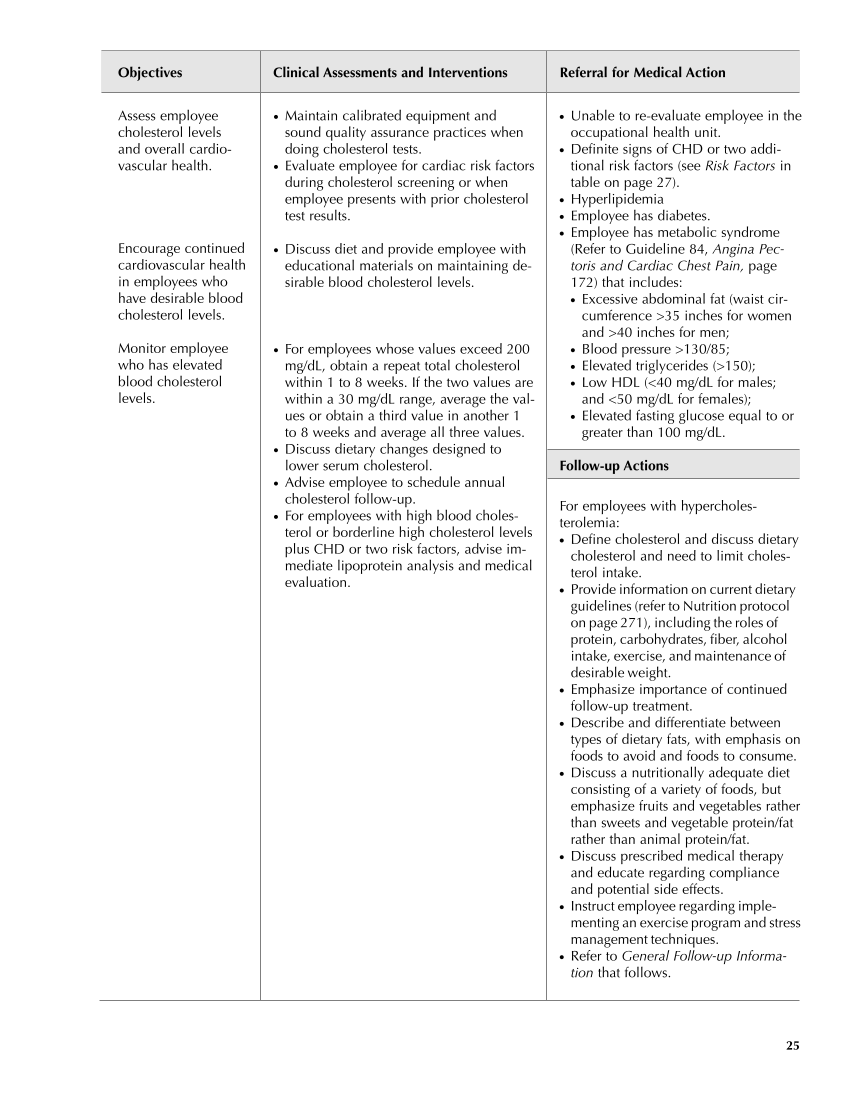● Unable to re-evaluate employee in the occupational health unit. ● Definite signs of CHD or two addi- tional risk factors (see Risk Factors in table on page 27). ● Hyperlipidemia ● Employee has diabetes. ● Employee has metabolic syndrome (Refer to Guideline 84, Angina Pec- toris and Cardiac Chest Pain, page 172) that includes: ● Excessive abdominal fat (waist cir- cumference 35 inches for women and 40 inches for men ● Blood pressure 130/85 ● Elevated triglycerides (150) ● Low HDL (40 mg/dL for males and 50 mg/dL for females) ● Elevated fasting glucose equal to or greater than 100 mg/dL. Follow-up Actions For employees with hypercholes- terolemia: ● Define cholesterol and discuss dietary cholesterol and need to limit choles- terol intake. ● Provide information on current dietary guidelines (refer to Nutrition protocol on page 271), including the roles of protein, carbohydrates, fiber, alcohol intake, exercise, and maintenance of desirable weight. ● Emphasize importance of continued follow-up treatment. ● Describe and differentiate between types of dietary fats, with emphasis on foods to avoid and foods to consume. ● Discuss a nutritionally adequate diet consisting of a variety of foods, but emphasize fruits and vegetables rather than sweets and vegetable protein/fat rather than animal protein/fat. ● Discuss prescribed medical therapy and educate regarding compliance and potential side effects. ● Instruct employee regarding imple- menting an exercise program and stress management techniques. ● Refer to General Follow-up Informa- tion that follows. Objectives Clinical Assessments and Interventions Referral for Medical Action 25 Assess employee cholesterol levels and overall cardio- vascular health. Encourage continued cardiovascular health in employees who have desirable blood cholesterol levels. Monitor employee who has elevated blood cholesterol levels. ● Maintain calibrated equipment and sound quality assurance practices when doing cholesterol tests. ● Evaluate employee for cardiac risk factors during cholesterol screening or when employee presents with prior cholesterol test results. ● Discuss diet and provide employee with educational materials on maintaining de- sirable blood cholesterol levels. ● For employees whose values exceed 200 mg/dL, obtain a repeat total cholesterol within 1 to 8 weeks. If the two values are within a 30 mg/dL range, average the val- ues or obtain a third value in another 1 to 8 weeks and average all three values. ● Discuss dietary changes designed to lower serum cholesterol. ● Advise employee to schedule annual cholesterol follow-up. ● For employees with high blood choles- terol or borderline high cholesterol levels plus CHD or two risk factors, advise im- mediate lipoprotein analysis and medical evaluation. Guideline continues on next page
Purchased from OEM Press by (ge corporate access). (C) 2013 OEM Health Information, Inc. All rights reserved.












































































































































































































































































































































































































































